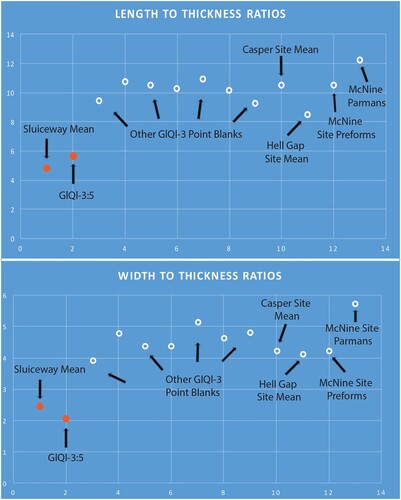Figures & data
Figure 1 (a) Location of GlQl-3 in the forks of the Peace and Smoky Rivers, to the northwest of Grande Prairie; (b) LiDAR imagery of the undulating terrain within which GlQl-3 is situated; (c) higher resolution LiDAR imagery of the same terrain immediately to the north of GlQl-3, near the Peace River. Maps and images courtesy of the Archaeological Survey of Alberta.
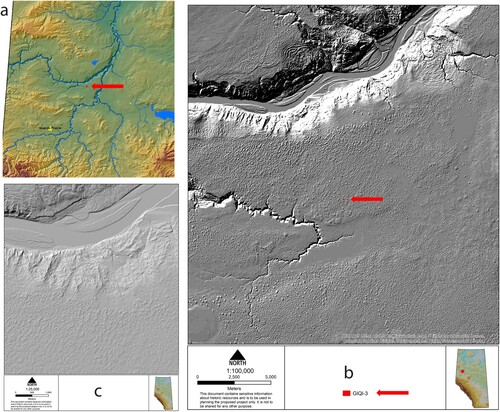
Figure 2 Unpatinated or lightly patinated surfaces of all the Poohkay (GlQl-3) artifacts recovered to date. Photographed courtesy of the Royal Alberta Museum.
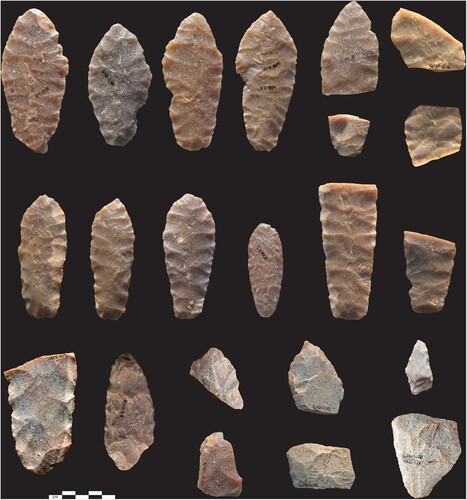
Table 1 Metric data and descriptions for all GlQl-3 (Poohkay collection) artifacts.
Figure 3 (a) Low magnification of patinated surface of GlQl-3:11 showing how quartz grains remain clear, while interstitial matrix turns a cream color. The arrow in (a) shows rounding created by the abrasion of arrises and edges of this artifact; (b) SEM image showing the abrasion affecting an arris on GlQl-3:2; (c) SEM image of GlQl-3:2 showing quartz crystals and matrix within a plow damage chip, where abrasion on the arris is absent; (d) Quartz grains and patinated matrix sampled on GlQl-3:2. Note the conchoidal microfracture occurring across the matrix and quartz grain, upper center, as well as the particles adhering to the matrix surface between the quartz grains. Photographed courtesy of the Royal Alberta Museum.
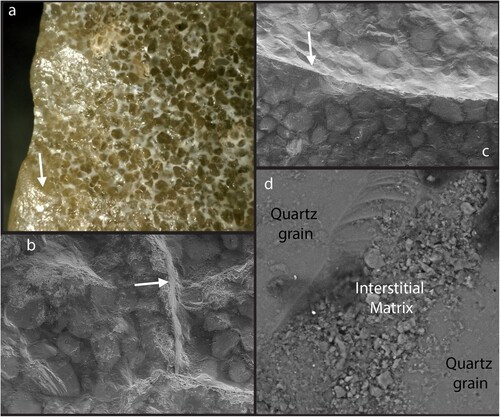
Figure 4 The non-patinated (or very slightly patinated) and patinated sides of the eight complete point preforms or points: top row, from left: (a) GlQl-3:2; (b) GlQl-3:3; (c) GlQl-3:4; (d) GlQl-3:7; (e) GlQl-3:9; (f) GlQl-3:10/11; (g) GlQl-3:12; and (h) GlQl-3:5. Photographed courtesy of the Royal Alberta Museum.
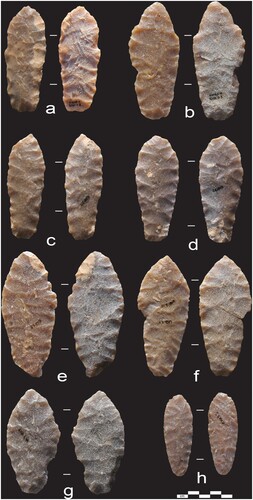
Figure 5 (a–c) Unpatinated side of preform base fragments GlQl-3:6, 17, and 24; (d–f) patinated side of the same three artifacts. The GlQl-3:10/11 tip and middle fragment and the GlQl-24 base might have been part of a single preform. Photographed Courtesy of the Royal Alberta Museum.
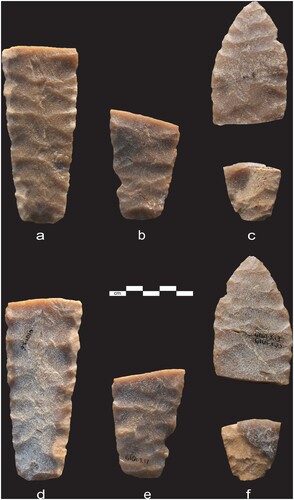
Figure 6 Both faces and line drawings of GlQl-3:5 (top), GlQl-3:7 (middle), and GlQl-3:2. Photographed courtesy of the Royal Alberta Museum.
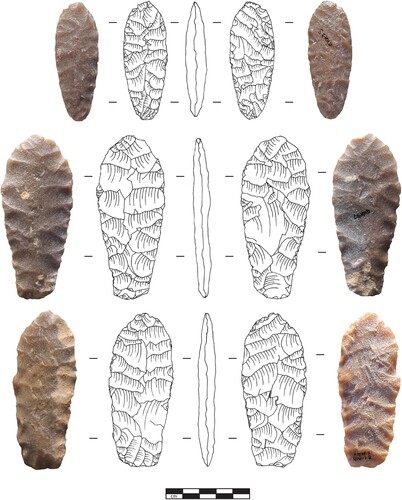
Figure 7 (a) Backlighting of GlQl-3:6; (b) lenticular cross section of GlQl-3:6; (c) backlighting of GlQl-3:7; (d) remnant facet at the tip of GlQl-3:4; (e) and (f) overshot flaking at the tip of the GlQl-3:13/23 refit. Photographed courtesy of the Royal Alberta Museum.
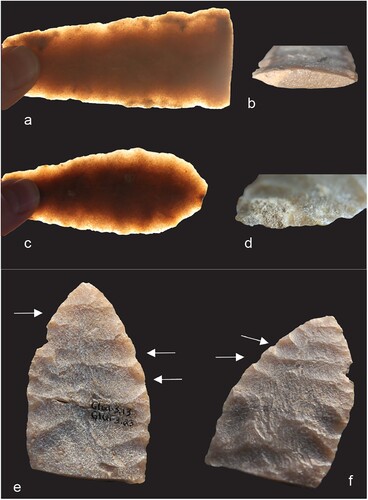
Figure 8 Both surfaces of: (a) biface fragment GlQl-3:14; (b) biface tip GlQl-3:18; and (c), shouldered biface GlQl-3:8. Photographed courtesy of the Royal Alberta Museum.
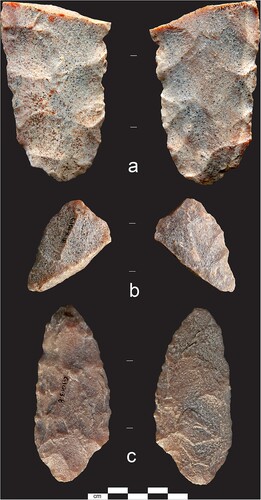
Figure 9 Both surfaces of: (a) unifacial flake tool GlQl-3:15; (b) unifacial flake tool GlQl-3:19/21; (c) unifacial flake tool GlQl-3:25; and (d) burin GlQl-3:22, where white arrows indicate the direction of the burin blow and the red arrows indicate the facets at opposite ends of an overshot flakes. Photographed courtesy of the Royal Alberta Museum.
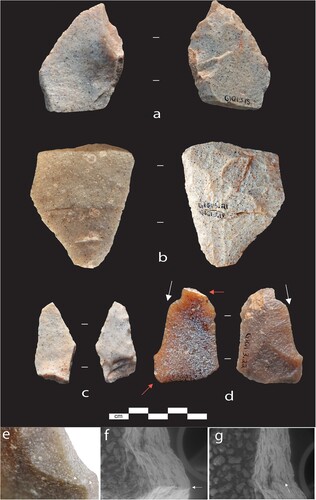
Figure 10 Top left, a narrower preform, GlQl-3:2, which with further finishing could have outcomes like the vitreous quartzite Graham collection point (from northwestern Saskatchewan) to its right, or the Agate Basin-like point from the Grande Prairie Museum collections, farthest right. Bottom left, GlQl-3:10/11, a preform with a broader tip toward its distal end, with possible outcomes like the cast of an Old River Bed Delta (Utah) Haskett point to its right, or a vitreous quartzite point (FiPp-33:13302) from the lowest component of Ahai Mneh in central Alberta, farthest right (see Ives Citation2023). Photographed courtesy of the Royal Alberta Museum.
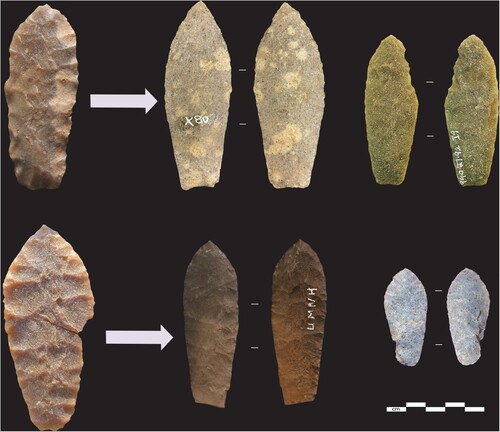
Figure 11 (a) Three views of GlQl-3:5 and (b-e), four typical Sluiceway points from the Caribou Crossing 1 site, Alaska. GlQl-3:5 photographed courtesy of the Royal Alberta Museum; Caribou Crossing 1 photograph courtesy Jeffrey Rasic.
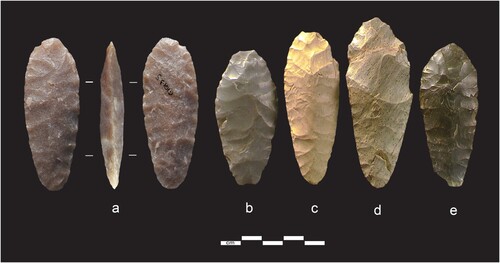
Figure 12 Top, length to thickness, and bottom, width to thickness, ratios for GlQl-3:5 and the other Poohkay preforms, presented with mean Sluiceway, McNine, Casper, and Hell Gap site values, showing how GlQl-3:5 is much closer to typical Sluiceway values, while the other Poohkay point blanks are closer to Western Stemmed Point tradition and Hell Gap values.
